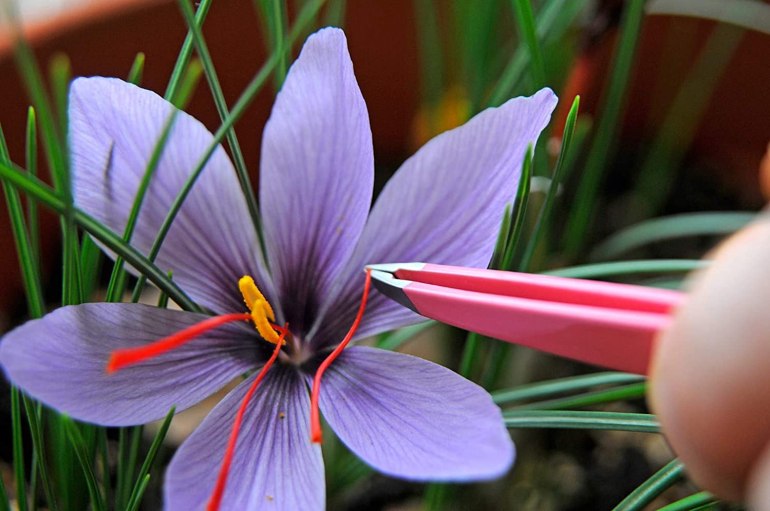Adding a few strands of saffron dissolved in water can give traditional recipes a distinctive oriental taste, why not?
Saffron is the most expensive spice in the world, with a pound (450 grams) costing between $500 and $5,000.
harvest
The crocus flowers are planted in summer, and are ready for harvest in mid to late fall.
The flowers should be picked by hand just before or after sunrise so that they are not damaged by the direct heat from the sun.
The flowers are very delicate, and many growers believe that mechanical picking damages and spoils them.
It takes between 15,000 and 16,000 flowers to produce one kilogram of saffron spice (Getty Images)
Each flower produces only 3 strands (strands) of saffron.
Once the flowers are harvested, the bristles should be plucked and dried for about 12 hours.
It takes between 15,000 and 16,000 flowers to produce one kilogram of saffron spice.
And it needs 5 workers, as it takes 370 to 470 working hours to produce this quantity.
The reason for its high price is the labor-intensive harvesting method, which makes production very expensive, as saffron is manually harvested from Crocus sativus.
Saffron originated in Greece, where it was respected for its medicinal properties. People eat saffron to enhance sexual desire, improve mood, and strengthen memory, but saffron has other health benefits that deserve to be highlighted.
One of the powerful antioxidants
Saffron contains a group of plant compounds that act as antioxidants, molecules that protect the body's cells from oxidative stress.
improve mood
Saffron has been called the "spice of the sunshine", not only because of its distinctive color, but also because it can help lift your mood.
According to studies, saffron supplements were more effective in treating symptoms of mild to moderate depression.
Other studies have found that taking 30 milligrams of saffron daily was just as effective as conventional treatments for depression.
Each flower produces only 3 strands of saffron (communication sites)
fight cancer
Studies have revealed that saffron and its compounds selectively kill colon cancer cells or inhibit their growth, while leaving healthy cells unharmed.
This effect also applies to the skin, bone marrow, prostate, lung, breast, cervix, and many other cancer cells.
May reduce PMS symptoms
Premenstrual syndrome (PMS) is a term that describes the physical, emotional and psychological symptoms that occur before the onset of menstruation.
Studies suggest that saffron may help treat PMS symptoms.
For women between the ages of 20 and 45, taking 30 milligrams of saffron daily was most effective in treating headaches and pain.
Another study found that simply sniffing saffron for 20 minutes helped reduce PMS symptoms such as anxiety and lowered levels of the stress hormone cortisol.
May reduce appetite and aid weight loss
Saffron may help curb appetite.
In an 8-week study, women who took saffron supplements felt significantly more full and ate fewer snacks between main meals.
However, scientists aren't sure how saffron curbs the appetite. One theory is that saffron lifts your mood, which in turn reduces your desire to snack.
Adulterated saffron test
As soon as many people know about the benefits of saffron, they rush to buy saffron from unreliable sources from the Internet and some anonymous sellers, so you must first check the saffron and buy it from a trusted party. Here are a set of ways to test the quality of saffron:
cold water test
Take a few strands of saffron and place them over a clear glass filled with cold water.
Both pure and variable saffron will release some of its color into the water, but the difference is that pure saffron will not release much color right away.
With pure saffron, you will notice that the threads slowly release a golden hue.
It may take about 10-15 minutes for the glass of water to turn completely yellow.
On the other hand, a deep red color in the water is not a good sign, you want a bright yellow color.
If you see a deep red color in the water, the saffron is likely adulterated.
It is best not to use this product as it likely contains harmful coloring chemicals.
Another thing to note is that the saffron threads should not lose their red color, while the adulterated saffron threads turn white after a short period of time.
Rub the saffron threads with your fingers
After soaking the saffron threads in cold water for a few minutes, rub the threads with two fingers back and forth a few times.
Pure saffron strands will not disintegrate, while adulterated saffron will disintegrate or turn into dust or liquid.
taste it
Another way to check the quality of saffron is to put strands of saffron in the mouth.
If you feel a sweet taste, it is a low quality fake saffron.
Remember that high-quality saffron smells strong, but never tastes good.
Use baking soda
You can mix saffron and baking soda in a small cup filled with water.
If the mixture ends up being yellow, it is pure saffron.

